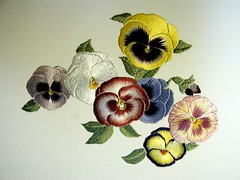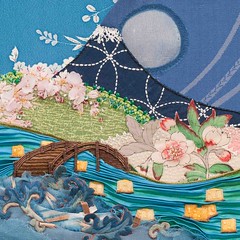It seems appropriate that my first day of returning to blogging happens to coincide with the opening of the The Great Tapestry of Scotland Exhibition.
The Exhibition is in the Main Hall of the Scottish Parliament building in Edinburgh and runs from September 3 through September 21, 2013.
I absolutely LOVE the story of this enormous achievement and I'm only sad that my trip to Scotland missed the exhibition by only a couple of weeks.
Those outside of the UK might be asking "What is the Great Tapestry of Scotland?"
In a nutshell, it is the longest stitched tapestry in the world with over 160 panels depicting all of the most important events in Scottish history. It is 140m long, 70 meters longer than the famed Bayeaux Tapestry. It took over 1,000 volunteers more than 50,000 hours to complete it.
 |
| Photo via Local News Glasgow |
The tapestry was the brainchild of Scots writer Alexander McCall Smith who was inspired after seeing the Prestonpans Tapestry...a 104-panel tapestry that describes the saga of Bonnie Prince Charlie's campaign to re-claim the crown in 1745.
After seeing this embroidered rendering of history, he asked, why not embroider an entire history of Scotland?
 |
| Picture courtesy of BBC News Scotland |
Scottish historian Alistair Moffett joined the team to help decide which events should and should not be included.
But how do you squeeze 12,000 years of Scottish history into one tapestry?
Through a "glorious process of ruthless editing", says historian Alastair Moffat.
"Pitfalls open on every side. One of the deepest is the military option, our history as a series of invasions, wars and battles, many of them grey defeats."
"Most important have been our efforts to make a tapestry that distils Scotland's unique sense of herself, to tell a story only of this place, and without bombast, pomp or ceremony, to ask the heart-swelling rhetorical question: Wha's like us?" --Emma Ailes, BBC News Scotland, 9/2/2013
I just love this sketch of Bonnie Prince Charlie whose coat is full of characters detailing his campaign, all drawn into a pattern resembling the embellishment of the day. I can't wait to see this one stitched...
The fact that the tapestry covers 12,000 years of Scottish history and is the longest tapestry ever completed is indeed, pretty "Great".
But what really makes it "Great" is the fact that the entire country was involved in the project and in deciding which panels to include.
It's "Great" because local stitchers volunteered and stitched on panels that were important to their personal history, community or geography.
Like this panel detailing the story of the Hillman Imp, Scotland's answer to the mini car and very popular in the late 60s and early 70s...
Photo via the Daily Record
|
It's "Great" because many of the stitchers added personal vignettes or motifs within their embroideries, enriching the tapestry with bits of their own stories.
If you want to search, you can read their stories in every local paper. The stories of stitchers who researched the history of their panels and involved others in their community to participate in some way...
I happened to stumble upon many bloggers who were also stitchers on the Tapestry.
I enjoyed hearing how they worked with the artist to refine the sketches for their panels and how one stitcher carted her embroidery in her backpack to and from work so she could work on her lunch break and complete her panel in time. Here are just a few that I found...
Most of the 1,000 volunteers were women but there is one panel stitched completely by men. Here is a list of blog posts from one of the male stitchers, thebargellist, describing his participation in the Great Tapestry.
There are many many more. Lucky for us, there will be a book published recording much of this information. The book is available for pre-order on Amazon here. And you can follow along by liking the Great Tapestry's facebook page here. If you have the time, it's worth going back to see and read many of the updates.
As I said before, my trip to Scotland preceded the opening of the exhibit, but we did find ourselves outside of Parliament at one point.
Beneath the Canongate building is the Canongate wall. Designed by Sora Smithson, the wall incorporates a range of Scottish stones carved by Gillian Forbes and Martin Reilly. There are 26 quotations carved on the wall from various poems, psalms and songs. Written in English, Scots and Gaelic, many of Scotland's best known writers are represented.
This one quote seemed to sum up my trip to Scotland and the sentiment of the Scots that I met there. It's a stanza from Sir Alexander Gray's poem, Scotland:
As I pondered, I was roused by a commotion nearby.
Two Americans, an elder and younger, were rough-housing...
Flesh of my flesh, to be sure. Some things never change.
As for me, I'm working on my own Scotland story with needle and thread...
I'm just beginning to turn this book into a stitched recording of our travels. Not quite the Great Scotland Tapestry but a story nonetheless.
My mind is still traveling through Scotland though my feet are firmly back on U.S. soil. Bear with me while I find my bearing.
And this Great Tapestry and Scotland has got me humming this song and thinking about recording my own life tapestry...
Update 9/5/13: Here's a link to a video about the Exhibition with lots of embroideries shown. It's only two mins. Enjoy.




























